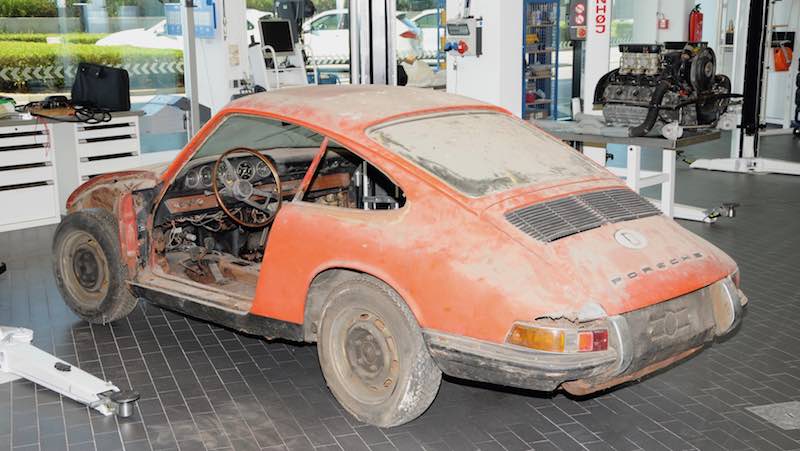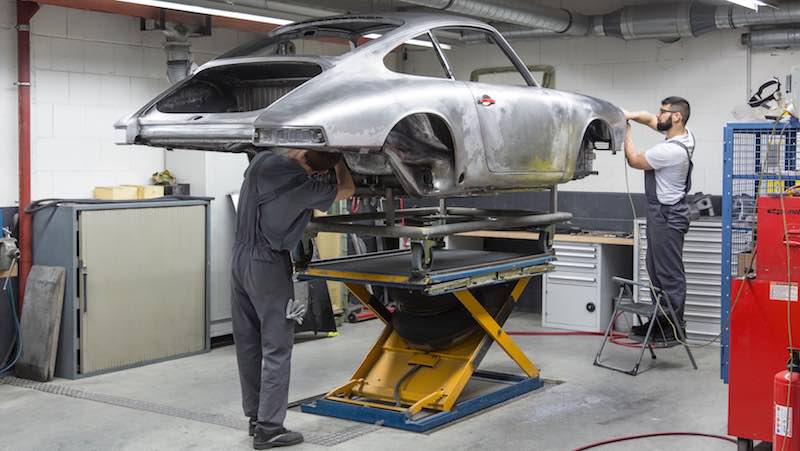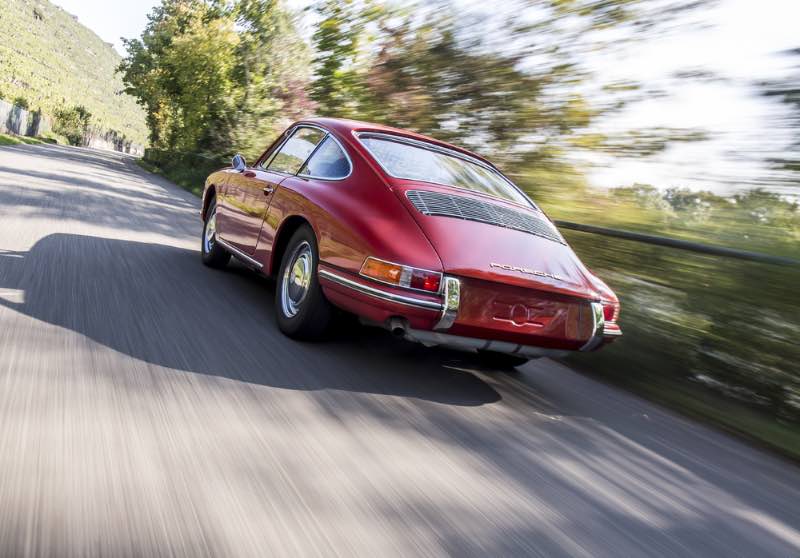The Porsche 901 is a legend. That’s because it was the forerunner of the 911. In the autumn of 1963, Porsche presented the 901 as a show car at the IAA.
One year later, Porsche unveiled a production-ready vehicle — but within just a few weeks, the coupe had to be renamed as a result of a trademark dispute with Peugeot. From then on, it was known as the 911. All of the customer vehicles produced up to that point were manufactured as 901 vehicles, but sold as 911 vehicles. For 50 years, the Porsche factory collection had lacked one of these rarities — until August 5, 2014, when a single phone call changed everything.
It was on this day that Alexander Klein, Manager Classic Car Collection at the Porsche Museum, received an enquiry from German television station RTL2. He was told that a couple of “barn finds” had been uncovered in the form of two old 911 vehicles. A team filming a documentary had found them while salvaging a long-abandoned collection. When they mentioned the number 300 057 in their description of the vehicle, “the penny dropped”, says Alexander Klein. This is the chassis number of one of the first 911 vehicles ever produced, built in autumn 1964 as a Porsche 901.
Eleven days later, two experts from the Porsche Museum went to a former farm in Brandenburg to inspect the two vehicles. They first encountered a gold-coloured 911 L from 1968 in a very poor state of repair. At the very back of the barn, for the most part still covered by a thick layer of dust, the two visitors from Zuffenhausen found the remains of a red 911. Both of its front wings were missing and large sections of the vehicle had already been eaten away by rust. Save for the instrument panel, most of the interior consisted of mere fragments. The brakes were seized, and so was the engine. But the chassis number was pristine, and it proved beyond all doubt that the vehicle was an original. One of the museum team’s long-cherished dreams was finally within reach: To have in its collection a 911 from 1964.
Time was running out — the car needed to be sold as soon as possible. In order to make the right offer, it was agreed that a detailed inspection should be carried out in Zuffenhausen. Two valuation reports provided by external experts delivered the same verdict, and it was far beyond the seller’s expectations. Porsche paid EUR 107,000 for the red original 911, and EUR 14,500 for the golden 911 L. The latter will remain in exactly the same condition: as an unwashed, living history.
The inventory carried out by the two experts revealed that a great deal of work needed to be done to the historically significant 911, henceforth known by the nickname “Number 57″. The engine and transmission were not the original units installed but were of an identical type. Many components were very heavily corroded and unusable. Other parts — such as the inner and outer sills on the right-hand side, as well as the front bumper and its mountings — were missing completely. Things didn’t look much better in the chassis area. All the axle and axle guide mountings on the front and rear axles had been severely affected by pitting corrosion. The two longitudinal beams in the area of the rear axle cross tube had rusted away completely. And these were just a few examples.
Nevertheless, the classic vehicle contained a number of details that delighted Kuno Werner, Head of Museum Workshop: “Many of the features only included in the very first models have been preserved in the car”. One example is the leather sleeve around the shift lever, which was only installed in this form during the 901 era. The experienced museum experts were also presented with a number of puzzles during their investigations. For instance, it was only after extensive research that the two square pipes under the seat adjustment system could be identified as a seat raising mechanism that was available from the factory.
The seats themselves have a history of their own. The Number 57 and the 911 L arrived in Zuffenhausen together with two pallet cages full of parts. In amongst this mish-mash of things were two 911 seats. It had been assumed that they belonged to the Number 57, but the backrests had five “pipes”, which was the name given to the vertically stitched subdivisions of the seat cushion. The first 911 vehicles had seats with six pipes. And the museum experts were surprised to find that the six-pipe seats were fitted in the gold-coloured model from 1968, which Porsche had bought at the same time in Brandenburg.
As usual, the restoration of the Number 57 started by completely disassembling the vehicle. This was done gently and with great care. Even if it proved impossible to save a particular component, there was still a chance that it could serve an important function as a sample part. The individual parts of the early 911 were then sent to a network of specialists at Porsche Classic and suppliers, as well as body engineers, saddlers and upholsterers.
The remaining torso was put into a chemical bath for derusting and paint removal. This procedure is much gentler than mechanical processes that use blasting materials. The surfaces that were uncovered were in exactly the same condition as when they were sealed over 50 years ago. “You can see exactly where any modifications have been made”, explains Kuno Werner. Discolouration in the metal indicates that it has been welded or that grinding machines have been used. If blasting is carried out, however, these traces may disappear because the blasting materials alter the surface. This is particularly important in the area of the chassis number, which is stamped onto a cross plate above the tank.
The Number 57 was the original — entirely untouched. Kuno Werner also identified the grinding marks in the roof as authentic: “Our colleagues back then must have needed to do some reworking”, he adds with a smile. His initial assessment was better than expected. Before diving into the vehicle, the experts had assumed that over 50 percent of the body had been destroyed. It now turned out that over half of the sheet metal was worth preserving.
The parts that needed to be replaced were supplied by the bodyshell of a 911 vehicle from 1965. This guaranteed that the composition, characteristics and quality of the sheet metal and steel would be as authentic as possible. The body engineers took the “donor” vehicle apart into its individual components. For example, the restoration workers drilled a small triangular piece of sheet metal out of the rear, welding point by welding point, and transplanted it into the body of the Number 57. The longitudinal beams were also replaced, as were all of the vertical, interior and exterior panels in the side skirts. And there was a surprise inside: Unlike in the later 911 vehicles, the heating pipes passed underneath the rear axle tube rather than over it. So while the heating pipes in the body of the other vehicle were accommodated in the sills, the supply lines were built from scratch at the relevant point. This was one of the few components that needed to be recreated from old sheet metal. New vertical plates, the front wings and front end of the later 911 body completed the reconstruction of the front.
The body engineers moulded and welded the steel and sheet metal for around 12 months. Piece by piece, the torso of the Number 57 was restored to its original condition. Then came the precision grinding stage, which involved mounting the glazing, bumpers, door handles, antenna, headlights and trims, as well as all add-on parts from Porsche Classic, on the unpainted body. By doing so, the experts ensured that the clearances in the body all matched up, as well as the distances and symmetries of the bumpers and overriders, panels and grilles. Even very small deviations were reworked or adjusted with bodywork tin.
The Porsche training workshop has traditionally acted as a supplier to the restoration workers. Detailed sheet metal work and paints are the most common items on the wish list submitted by the museum workshop to these trainees. In the case of the Number 57, for example, the museum ordered a bracket for the exhaust system and a brake anchor plate. The trickiest task for the budding body engineers was the restoration of the ashtray. The rear third of the slide-in unit had rusted away and the chrome-plated support with a rectangular hole for a cigar was missing. It was typical in models from 1964 for the rectangular hole and thus the cigar holder to disappear as early as the following year. Both needed to be replaced. Modellers from Weissach provided a wooden mould into which the trainees tapped, pressed and rolled the fragment of the ashtray.
But even for the Number 57, authenticity has its limits. When it came to the layers of paint, for example, the restoration workers opted for modern coating processes and their superior protection against corrosion. The body of the classic vehicle was therefore dipped in the same cathodic dip coating bath as today’s 911 vehicles. This CDC process is considered to offer the best rust protection currently available. Another significant advantage is that the paint film also forms an optimally sealed layer in cavities and angles.
Authenticity also had to take a back seat in respect of the Signal Red 6407 paint colour. Instead of the original mixture of solvent-based paints, the specialists developed environmentally friendly water-based paints. In line with the original plans for the application of black paint, the red paint was also covered in certain areas – such as around the cutouts for the fittings – in order to prevent the colour showing through the gaps. However, the luggage compartment and the underbody were given a PVC coating, just like in the original.
Porsche Classic took on the task of reviving the engine. The cylinder heads and control system could be removed without any problem, but the pistons were stuck fast in the cylinders. A combination of rust remover, heat, time and patience finally brought away the crankshaft. The crank mechanism was then rebuilt in its entirety from new genuine parts. However, it was possible to restore the cylinder heads. The right-hand camshaft was returned to its rightful place, and a genuine new part was installed in place of the worn left-hand camshaft.
Over the course of around 120 working hours, the six-cylinder engine was painstakingly restored to perfection. One of the reasons it took so long is because of the care required. Even the smallest of mistakes might have irreparably damaged this historically significant machine. On top of that, a significant amount of intuition and creativity were often required. Many of the parts were not held in stock by Porsche Classic. For example, certain clips on the carburettor linkage had to be reworked in order to restore the original synchronous control. In spring 2017, the engine was put into operation for the first time on the test stand, ready for installation.
The chassis and drive, seats and fittings gradually returned from restoration in autumn 2016. But there were a large number of areas that still required work during assembly. Some of the problems were extremely detailed in nature, like the shape of the screws that had originally been used to mount the indicators. It was possible to retain all of the original glass in the vehicle, but the cable harness was replaced with an adapted replica for a 911 vehicle in the later F series.
In order to restore the original design of the interior roof lining, the restoration workers had put the best preserved piece carefully to one side when disassembling the vehicle. The square pattern of holes seen in the very early 911 vehicles was later replaced by a diamond shape. The original tool was one of the few from the 1960s that remained intact. This spiked roller, which was used to stamp patterns when repairing the roof lining or the panels, made it possible to restore the original pattern of the interior roof lining.
In summer 2017, the “marriage” of the Number 57 took place as the flat engine returned to its rightful place. After some final fine-tuning, the oldest 911 vehicle in the Porsche Museum was given its new lease of life in the autumn.
—
After three years of restoration, the Porsche Museum will finally present one of the newest additions to its collection at the special exhibition “911 (901 No. 57) — A Legend Takes Off” from December 14, 2017 to April 8, 2018. For more information, visit Porsche Museum.
[Source: Porsche AG]


































